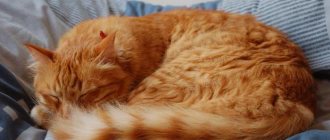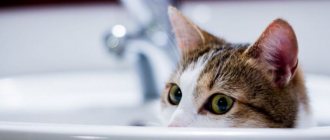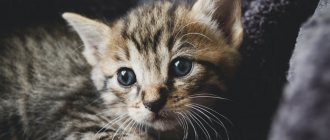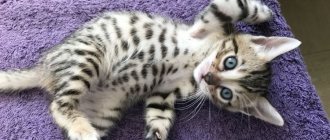Behavior
Scratching surfaces for a cat is not only grooming for its claws, but also a way to express a very strong instinct - to mark its territory. At the same time, the cat not only leaves visible marks - claw marks, but also deposits on the surface the secretion of the glands on the paw pads, the smell of which is smelled by all cats. Scratching helps the animal maintain psychological balance, feel comfortable in its territory and train the corresponding muscles. Owners and veterinarians have noted changes in personality in declawed cats. Previously active, friendly animals become unsociable and withdrawn. This is primarily due to the cat’s loss of self-confidence and the ability to defend itself. Often, deprived of their usual means of defense, cats become nervous, frightened, aggressive, constantly using the last remaining weapon - their teeth. Constant stress caused by a feeling of defenselessness can lead to weakening of the animal's health. Some cats stop using their litter box; it may be associated with the discomfort experienced when trying to “bury” the filler.
This is interesting: Top cat foods are educational
Advantages and disadvantages of declawing cats
It doesn't take long to remove a cat's claws. But are there any advantages from this? Yes, I have. This is the impossibility of damaging furniture and the absence of scratches on the skin of household members.
But the disadvantages include a number of points:
- anesthesia is not just a dream, but stress for the body;
- the animal is in great pain for a very long time after the operation. The pain is dulled with various painkillers, which is also considered an intervention in the body;
- the phalanx may grow back and require repeated surgery;
- This is real stress for a cat, which not every animal experiences without consequences.
- a cat without claws is defenseless, and any trip outside can end in disaster;
- as a result of onychectomy and a feeling of vulnerability, the pet may use its teeth;
- the pet’s character changes, it may become withdrawn;
- Difficulties with the toilet: sometimes cats refuse to go to the litter box due to the inability to rake;
- the animal will never step on the entire foot completely again in its life, which affects its gait.
Therefore, maybe it’s worth thinking about other options for protecting furniture from cat scratches?
Fractured paw in a cat: treatment
Many online resources provide advice on transporting a cat with a fracture. However, we strongly do not recommend moving the animal at all.
. If it's closed, no one knows what's inside. For example, if there are multiple fragments, moving may be too painful for the pet.
Our veterinary is represented in several strongholds in Moscow. Experienced veterinarians are ready to respond to an urgent call to your home and will be there in less than 40 minutes. The presence of professional equipment, necessary certificates and diplomas will show the seriousness and professionalism of our employees. If surgery is required, doctors will quartz the room on site to make it sterile. After all, the main thing is to have time to take the necessary actions in order to save not only the pet’s paw, but also its life.
There are two methods of treating such injuries; let’s look at them in more detail.
Conservative treatment - fracture of a cat's paw
Conservative treatment means treatment that does not involve surgical intervention in the animal’s body. Most often, the procedure begins with pain relief, after which the bone is collected and folded by palpation (if necessary), and then a splint or plaster is applied. The bandage and plaster should secure nearby joints. A new type of gypsum is used in modern medicine
, which is lighter and more durable. If the fracture is minor and consists of a crack, then a cast is applied for 15-20 days. If it is more serious, then for a month or a little more, depending on the situation.
To make the animal suffer less, at first they may be prescribed a painkiller. Some ointments and medications may also be prescribed to avoid inflammation or infection in the case of an open fracture. Then everything is simple - you just have to wait and sometimes give injections that accelerate the growth and restoration of bone tissue.
A young cat literally takes 3 or 4 weeks to recover
, older ones on average take twice as long to recover. But in general, the prognosis is almost always comforting, because in matters of fracture, due to their frequency, medicine has made great strides forward.
Surgical treatment of broken bones - broken paw in a cat
If the fracture is multiple , open, depressed or of any other severity, then you simply cannot do without a veterinary surgeon. He performs osteosynthesis surgery - connecting bones and fixing them. After they grow together, the special knitting needles are removed and regular plaster is applied, if required.
- Osteosynthesis– a rather complex operation, at the moment there are three methods:
- Intramedullary osteosynthesis . Broken bones are connected using a rod that holds and holds them together. In severe situations, it can come out and be secured with screws. The rods are not removed once the effect is achieved; this is the main danger and complexity of this procedure. However, the technique is used quite often and is popular.
- Extramedullary osteosynthesis . A plate is placed on the damaged bones, which is attached to them using nails and screws. It is securely fixed and this allows the bones to grow together faster. This method is the most common and popular. It is not suitable only for particularly fragile bone tissues and for young kittens.
- Extrafocal osteosynthesis . The entire paw is fixed around the perimeter using special iron knitting needles. The disadvantage of this method is that it is inconvenient to use and takes a long time to recover.
Fractured paw in a cat: rehabilitation
After a fracture, it is important to adhere to the doctor’s instructions and instructions. Even after removing the cast and wires, you need to give time for recovery. Therefore, it is worth limiting physical activity, giving your cat the necessary vitamins and minerals prescribed by a doctor, feeding it with special food, and also regularly checking with a veterinarian.
Since in this condition it is better not to disturb the animal again, we recommend calling a doctor to your home. He will examine the animal and note its recovery, while giving advice on food, vitamins and other ways to quickly restore the pet’s physical activity.
Of course, it’s worth talking about different deadlines here. If with a broken paw the recovery period can reach two months, then with a broken tail the animal will feel fine within a month. Unfortunately, there are also cases when the animal remains disabled and it is necessary to use prosthetics and wheels so that the pet can move. However, medicine has come a long way and such cases are rare. Only if the owner sought veterinary help not too late.
Contraindications and consequences for cats
One of the main contraindications to the manipulation is to take the cat outside for walks, as the cat may be injured after the procedure.
Surgical intervention is not resorted to in situations where the pet leads a street lifestyle. As for postoperative complications, the intervention can cause stress in the cat. Animals feel defenseless, so changes in their behavior are often observed. Pets may prefer to be alone, avoiding contact with their owners. The opposite situation can also happen when the cat becomes aggressive and lets in a second weapon - teeth.
In addition, anesthesia, even gentle, does not benefit the body of pets, but vice versa. The animal leaves him for about a day. The rehabilitation period does not always go well; sometimes the animal experiences pain for a long time while walking. The possibility of wound infection cannot be ruled out. This is especially true in situations where the operated paw was not bandaged or the owner does not follow the recommendations for postoperative care.
There are cases of changes in gait, as well as loss of coordination of movements. These complications are caused by a decrease in the support area. After surgery, the cat is forced to step on its feet instead of its toes. Diseases of the musculoskeletal system can also develop. After soft paw surgery, the load may be unevenly distributed, which is why curvature of the spinal column or osteomyelitis sometimes develops.
Claw amputation
Soft cat paw surgery is called an onychectomy. It is performed under general anesthesia. This is a relatively simple procedure and consists of amputating the first phalanx of the fingers, that is, the claw itself and the place from where it grows. The operation lasts about half an hour.
To the popular question of owners whether it is possible to remove a cat’s claws forever, we can give a positive answer if the operation is performed correctly.
If you are planning to remove the claws of a kitten, but you doubt at what age this operation can be performed on him, then there are no special restrictions. The main criterion is the kitten's ability to tolerate anesthesia, so it is advisable to conduct an examination before surgery.
At the same time, there is a lower age limit - no earlier than eight months. At this age, the cardiovascular system is already ready to tolerate anesthesia. As for the best psychological adaptation of the animal after surgery, the suitable age for surgery is from six months to a year.
Thus, according to two criteria, the most favorable time for onychectomy is the age of 8-12 months.
At what age can the procedure be performed?
Kitten declawing should be done before one year of age.
It is advisable to rip out a cat's nails at the age of 7 months. This way, the animal will rehabilitate faster after the operation and get used to living normally with the added changes, without even feeling any particular inconvenience. At an earlier age, cats have weak nail plates that are easier to remove.
The operation “soft paws” is also called onychectomy. This is a relatively simple procedure that is performed under general anesthesia. Before subjecting an animal to this operation, it is necessary to consider reviews from owners about declawing cats. Owners of such animals have two conflicting opinions about this procedure.
The fact is that during the surgical procedure, the cat’s upper phalanges on the forelimbs are removed. In this case, not only the claw is removed, but also the place where it grows. For some owners of four-legged pets, this operation becomes the only way out to keep the animal in their home.
However, a lot of negative reviews make you wonder many times whether it is worth exposing your cat to such suffering. Many people believe that such surgery is too cruel. There are several arguments for and against declawing. You should learn in detail about all the features of the operation.
The operation should only be performed by a qualified doctor
The animal is under general anesthesia during the procedure. The operation is quite complex and must be performed by a qualified specialist. The doctor uses a scalpel to remove the first phalanges of the fingers.
The operation is primarily performed on the front legs, but at the owner’s request it can also be performed on the hind legs. If the procedure is performed correctly, the cat will be able to stand on its paws the next day. The lameness will disappear in 5–7 days.
Possible alternatives
Amputation is a fairly painful procedure and can not only affect the way your cat moves, but also change the appearance of the limbs.
For those who do not want to subject their cat to this procedure, there are several alternatives:
- teach the animal from a very early age not to scratch furnishings and household items. You should try to find compromises in your relationship with the cat, because scratching objects makes her happier and is a natural behavior, and a few scratches on the furniture that she will leave behind during the training stage are not such a high price to pay;
- build or purchase a scratching post (“scratch”) for the animal, teach it to scratch this particular object. You should make sure that the product matches the length of the cat and is not too high or low;
- trimming nails. You can trim the ends yourself after studying the technique, invite an experienced groomer, or go to a veterinary clinic;
- claw covers. Silicone attachments glued to the animal's claws will not cause him any discomfort. They stretch along with the growth of the claws and are designed to last a month. You can buy caps in different colors and give your pet a real “manicure”.
Claw pads
Conclusion
Instead of removing your cat’s nails, you should first of all analyze and try to find a suitable humane method for solving the “claw problem.”
Owners may believe that this is one of the quick ways to once and for all get rid of unwanted scratches when interacting with an animal or damage to furniture, and that this argument outweighs. However, it is most likely that the cat will change its behavior, for example, begin to bite, or become more aggressive. Onychectomy can also cause physical health problems in your furry pet.
If illnesses of the owner or members of his family still force the owner to undergo a removal procedure, then it is worth noting that parasitic infections of cats transmitted through cat litter pose an even greater health risk. The greatest danger comes from pet bites or diseases transmitted by cat fleas. It is not for nothing that many official institutions condemn this type of operation, except for the cases described above.
In Russia, this procedure is not prohibited, but only the owner is responsible for the fate of the creature that he has taken under his care, because after all, the main task is to create a favorable atmosphere for the life and development of the pet.
Reasons for declawing cats
The logical question is: what is the reason to remove claws from an animal that literally survives on them?
One of the main reasons is the animal’s unreasonable aggression. There are numerous stories when a cat, previously an “angelic creature,” suddenly turns into a fiend of hell. He destroys everything in his path, cripples his household, guests and even himself. In this case, onychectomy is the only possible solution.
A common reason why people decide to declaw a cat is the cat's natural instinct, coupled with its unbridled and violent temperament. Nature dictates that cats need to have their claws sharpened. By scratching, they remove the top dead layer of cells, thereby regenerating the cells. Unfortunately, most often cats do not use a scratching post, but a sofa or other furniture.
The phenomenon of onychectomy itself appeared in medicine. It is used in the following cases:
- Illness that threatens the cat’s life (epilepsy);
- Diseases transmitted through blood by scratching;
- Incoagulability of blood, which makes scratching life-threatening;
Declawing cats is a measure that should be resorted to only in cases where there is a danger to the life and health of the animal or the people around it. In any case, first ask yourself whether you have done everything you can to help the cat. Maybe you can avoid this procedure, take a look at alternative solutions to the problem.
Declawing: consequences of surgery for cats
Cats are perhaps the most beloved and popular pets in the world. The owner is ready to endlessly please and pamper his pet. But even such cute creatures can sometimes cause trouble in the form of damaged furniture upholstery, a scratched chest of drawers or other household items. To prevent troubles from overshadowing a warm relationship, you can perform a procedure such as declawing cats, or, as veterinarians call it, “soft paws.”
How to care for a cat after surgery?
To ensure that the rehabilitation period passes as quickly as possible, you must follow the following recommendations for caring for your cat after surgery:
- Provide your pet with a comfortable bed in a warm place, next to which there will be a bowl of food and clean drinking water.
- For the first 10–12 hours, it is necessary to limit the cat’s movements. During this period, the pet should not jump on its paws from a height and move independently.
- Every day for 3-4 weeks you need to change the bandage and treat the incision site with an antiseptic solution.
- You should purchase a protective collar in advance that will prevent the cat from tearing off the bandage.
- In the first 7 days, it is better to replace the dry filler in the tray with regular newspaper or paper.
- For the first 2-3 days, the cat must be closely monitored so that it does not jump from great heights. During the jump, cats land on their toes, which will cause the animal great pain.
- If there is heavy bleeding from the wound, the animal must be urgently taken to the clinic.
- In the first 5-7 days after surgery, the doctor may prescribe a course of antibiotics to eliminate the risk of complications.
Will a cat's fracture heal without a cast?
Very often, when falling from a great height, as a result of road accidents and fights, cats need medical attention.
When is a cat put in a cast?
As a result of falls from great heights, animals are injured, most often these are fractures of the limbs, tail, dislocations, but there may be injuries to the skull and spine.
Signs of such injuries are: pain when palpated at the site of a fracture or dislocation, lameness, swelling of soft tissues (edema), general restlessness of the animal. In case of fractures and dislocations, the first thing to do is to immobilize the limb, rest the animal and seek professional help from a veterinarian.
Most often, a cat's cast should be kept for at least 30 days, but with proper care this period can be reduced.
Cat in a cast
Since cats are very active animals, the applied cast will greatly disturb them, and they will try to remove it. Therefore, while the cat is in a cast, it is best for him to wear a postoperative collar, which should be removed periodically so that the animal can wash itself, or a sock, which is tied to the back with ties.
It is also necessary to monitor your pet’s diet, since nutritious food rich in proteins and vitamins promotes faster bone healing. In kittens, a simple fracture with adequate nutrition heals in 2-3 weeks.
It is necessary to strictly ensure that the limb below the fracture does not swell, that an unpleasant odor does not emanate from under the plaster and that biological fluid (ichor, blood, pus) does not ooze. If any of these signs appear, you should immediately consult a doctor.
It is also necessary to ensure that the plaster cast does not get wet and that dirt does not get under it, which can contribute to the development of fungal diseases and infections.
Try to provide your pet with peace, limit his movements, as with very active games a re-fracture may occur.
Letting an animal go for a walk alone with a cast on its limb is strictly prohibited. In this form, the animal is defenseless.
Do not try to apply or remove a cast on your pet yourself; entrust this task to professionals.
The cat fell from the 7th floor at night, lay on the asphalt until the morning, and was attacked by a pack of stray dogs in the morning. Good people fought him off and were able to pick him up and carry him into the entrance of a neighboring house. We looked for it for a long time and found it by chance, but towards evening. They immediately took us to the clinic (our closest one is Obereg on Ilimskaya)
From the card: the condition is extremely serious, lying on the side, T=33, pale mucus, anemic, pink tongue, shortness of breath, dehydration 12%.
X-ray shows lateral view: pneumothorax
Biochemical blood parameters are normal, bilirubin is slightly elevated.
We don’t know the exact age, because... taken from the tree in the fall. Approximately a little over a year. The cat is outbred, medium-sized, very strong, light and lean (despite the fact that he is neutered).
The clinic said that plaster cannot be applied to such a fracture, and surgery cannot be done either - the fragments are very small.
8 days have passed since the fall. The cat began to eat on his own, the maintenance drips were canceled, and we only injected him with Sinulox. The shortness of breath has disappeared.
They put him in a one-meter rabbit cage to limit his mobility. The cat mostly lies down, but to go to the toilet and eat he stands on 4 legs, sways, his back leg bends, his pelvis looks unnatural, and he walks a little.
There seem to be no problems with bowel movements and peeing. Everything is regular, as usual and without any visible discomfort. He even tries to bury himself (he put the filler in one of the corners of the cage). He eats dry food and has a normal appetite. Tries to play with his favorite mouse with his front paws. But the eyes are painful and sad.
Please answer the following questions:
The cat is very active, playful and curious. He meows not in pain, but only when he is completely bored in the cage. He endures pain stoically.
2. Is it still possible to somehow fix the pelvis and thigh? Maybe there is some kind of bandage or support corset design? It’s very scary and painful to watch how his paw is giving way, but he also can’t not move at all and not get up.
3. How and how long can such a fracture heal in a one-year-old cat? How long do you need to keep him in the cage?
For now, I’m even afraid to ask what the chances are that the bone will heal correctly. =(
Thank you very much in advance!
Here is a photo of an x-ray of the pelvis:
Alternatives to Onychectomy
An alternative to declawing is to teach the cat to sharpen its claws in a specially designated place (scratching post), trimming the dead sharp tips of the claws with nail clippers or a special nail clipper, as well as “soft claws” - silicone stickers on the claws that are attached with glue like false nails in humans. . All these methods are not traumatic, do not interfere with the cat or injure it, are painless and safe. If you use claw covers, after some time of wearing they come off (usually 2-4 weeks, as the claw grows and peels off), and the procedure must be repeated. In these overlays, the claws at the tip are blunt and soft; the paw will not be able to scratch a person or damage furniture. You can purchase them at pet stores and veterinary pharmacies.
All about soft paws
Every owner should know that first of all, this is a surgical operation to completely remove the claw phalanx. It's called onychectomy. This procedure is performed not only for cats, but also for other animals:
This intervention always takes place under general anesthesia. The owner can do it for his pet at will, and there are also medical indications:
- Aggression that the animal cannot cope with.
- Damage to the phalanx of the claw.
It is necessary to take a responsible approach to the preparation of the pet and the postoperative period
By agreeing to the “soft paws” procedure, the owner deprives the pet of an important part of the body that he uses daily, and in 90% of cases without medical indications for this
Things to know
After onychectomy, the owner must be prepared for irreversible changes in the character, behavior and physiology of the animal. During surgery, a cat may lose a lot of blood, which can lead to a lengthy recovery process and, in some cases, death. Immediately after surgery, it is necessary to carefully monitor the sutures to avoid damage and infection.
Usually the recovery process takes much longer than doctors promise. Complications such as osteomyelitis and tissue inflammation are not dormant. The animal's coordination of movements permanently deteriorates. If previously a cat could climb onto the neighbor’s balcony to see his “Juliet,” now the evening promenade can end sadly.
According to owners of cats who have undergone declawing procedures, the most common problem is litter box refusal. The cat can no longer dig into the litter and is able to change the place for its toilet, which is unlikely to please the owner.
Even when onychectomy cannot be avoided, the doctor will remove only the affected phalanges, leaving the rest intact so that the animal can feel full and return to its usual activities.
Rehabilitation and cost
After removal of the claw phalanges, the animal requires careful care and care from the owner. Usually the doctor gives the following recommendations:
- Use painkiller injections strictly as prescribed by your veterinarian.
- Bring your cat in for a checkup every three days.
- Change dressings and treat wounds at least once a day.
- Do not remove the special collar (the animal always tries to chew off excess and lick its wounds).
The price for onychectomy can vary from 1.5 to 5 thousand rubles depending on the region, the popularity of the clinic, and additional physical procedures. Having decided on the need to remove the claw phalanges, you should not save. First, you should study the websites of suitable clinics to make sure that they specialize in surgery. When visiting a veterinarian, you should ask to see the appropriate license.
If possible, it is better to choose an institution where it is possible to call a surgeon at home, because in a familiar environment the animal will receive the least stress. In this case, the recovery process will also be faster.
Alternative to claw pulling
Onychectomy is a traumatic, dangerous and painful procedure
It is important to understand that everything can be solved without resorting to the help of a surgeon and without being guided by your own whims. First of all, look around to see if it is possible to make any changes to the interior without compromising the style and comfort of the animal
Manufacturers of scratching posts produce products for every taste - equip your cat with a special place for scratching its paws. For a successful and pleasant first acquaintance, you can sprinkle the scratching post with catnip or sprinkle with drops of valerian. The owner can make such a device himself from an old rug and several planks.
If the animal scratches during play or "March season", you can trim its claws. This procedure can be done either at home or by taking your pet to the veterinarian.
It is important to remember that only the sharp edge is cut off. This complex procedure is best performed when the pet is dozing or in a state of relaxation.
Another modern method is silicone covers for claws. In this case, you need to choose a model that is suitable in size and shape. Special glue is poured into the cap, and it is immediately put on the claw. It is necessary to immobilize the animal for some time for the adhesive mass to harden. With such pads, both the furniture and the owner’s hands will remain intact, and the pet will avoid the cruel operation with the beautiful name “soft paws”.
What is “soft paws for cats” operation?
Declawing is a controversial method in veterinary medicine.
Onychectomy or “soft paws” surgery is a surgical procedure that involves removing the terminal phalanx of the cat’s fingers along with the claws. Medical indications for this operation are pathologies of the metatarsus or metacarpus that are not amenable to other treatment methods. But recently, such surgery is widely performed as a cosmetic procedure. In this way, pet owners strive to prevent damage to furniture and clothing.
When all the means to re-educate the cat have been tried and the question arises, the owner of the animal thinks about where the declawing procedure can be done and what its consequences are.
Let's start with the fact that any surgical intervention carries a certain risk:
- Some animals have difficulty recovering from anesthesia
- After the operation, any complications may develop.
Onchyectomy (claw amputation) is the removal of the claw, distal phalanx. There is a second version of this operation, when the tendon of the flexor muscle of the finger is removed, and because of this the claw remains in its bed, the cat cannot “release” the claws.
During this operation, only the claw phalanx is removed. When the limited access method is used, self-absorbing sutures are applied, this allows the wounds to heal quickly, and the animal, especially the kitten, quickly adapts and lives a normal active life.
Operation soft paws has relative indications for use, since no one can call this intervention necessary for health reasons. But still, the aggressive behavior of the animal and the ineffectiveness of using alternative means forces the owner to resort to this last resort.
Cases are described when an animal, in a fit of anger, or playfully, scratched the face of a child, and attacked the owner at night. Ordinary scratches in weakened people, the elderly and children can cause a complication - felinosis. This infectious disease, caused by bacteria of the genus Bartonella, is characterized by fever, swollen lymph nodes, and in severe cases, conjunctivitis, damage to the nervous system, enlarged liver and spleen, and blood poisoning. Every cat scratch should be disinfected!
A contraindication to amputation of claws in cats is the cat’s free stay at home and on the street, since it is deprived of the opportunity to stand up for itself in the event of an attack, climb a tree, catch its claws when falling, etc. By deciding on this operation, you take responsibility for life and safety defenseless creature.
If you have made a conscious decision to undergo the “soft paws” surgical procedure, then it is important to find a good veterinarian who will competently and skillfully perform this operation. It is usually performed under general anesthesia. No one “rips out” the claws, the doctor carefully removes them using special tools, the pillows are not injured, sutures are placed on the incisions, it is better if they are absorbable. The paws are bandaged to protect them from bleeding. Additional medications may be prescribed to help the cat recover better from anesthesia.
Usually after 6-10 hours the cat can already move independently. It is recommended to keep an eye on her for at least a day or two until she completely recovers from anesthesia; this time is individual for each animal. Veterinarians recommend providing the animal with a comfortable bed on the floor, limiting walking and jumping in the first hours after surgery, and not allowing jumping from a height.
We invite you to familiarize yourself with: Color point cat breeds description and color varieties
A day or two after the operation, the paws may bleed, and it will be uncomfortable for the cat to step on them, but within 10-12 days everything should return to normal, and the cat will continue to run, play and jump on cabinets.
On the Internet you can find a lot of “horror stories” about onchyectomy. The opinion is expressed that the animal becomes disabled with a broken psyche, its character changes for the worse. Cats move worse, the harmony of the musculoskeletal system is disrupted. But the cat’s claws are not used when walking and supporting itself, since it rests on the first and second phalanges of the fingers, and the last claw phalanx remains retracted. Claws are needed only for hunting and protection from enemies.
Complications after this operation, a description of which can be found on the Internet, occur as a result of poor quality performance: a fragment of the distal phalanx was left, non-absorbable threads were used for sutures, and aseptic conditions were violated.
There are also cases described when a cat becomes cowardly, aggressive, and unkind due to the “soft paws” procedure. Most people who agree to this operation for their pets do not notice such negative changes in the cat’s character; its gait, coordination and behavior do not change.
Of course, it is up to you to decide whether your pet needs to be declawed. Often, owners try more gentle methods of exposure - repellent sprays, various scratching posts, claw trimming, silicone pads. And only after making sure of their low effectiveness do they resort to this procedure.
After weighing all the pros and cons, do not blame yourself if the cat puts out its claws in places and places out of place, but seek qualified veterinary help. Not all veterinary clinics perform this operation, but if it is included in the list of services, ask how it will be performed, what materials will be used, whether the veterinarian monitors the patient’s recovery from anesthesia and other questions that interest you.
If you find an error, please highlight a piece of text and press Ctrl Enter.
Most owners are faced with the fact that sooner or later there comes a time when their pet injures them with sharp claws for various reasons. In such situations, the animal's nails should be trimmed. However, such manipulations will need to be carried out constantly.
There is a special procedure for declawing cats - onychectomy (soft paw surgery). This is a surgical removal with which the claw phalanges are completely amputated. This removal method allows you to permanently tear out the claws with the first phalanx of the toe on the animal’s front paws.
We must not forget that various changes can occur in a cat’s body after declawing through surgery. Possible consequences and complications after surgery:
- Inflammatory processes occurring in soft tissues.
- Long rehabilitation process.
- Change in movement coordination. The animal will only use its paws to grab objects, but will not be able to normally jump onto furniture or any surfaces. She will also lose the ability to defend herself.
- Negative reaction to anesthesia.
- Ignoring the tray.
- Psychological stress that will affect the cat's life.
- Severe pain in the suture area. Because of this, it is necessary to properly maintain the animal’s condition after surgery and not allow it to overexert itself.
If you want to perform an onychectomy, you must take the animal to the clinic for veterinary care. Only experienced specialists can perform the operation efficiently and without complications. However, you have to pay for surgery.
The cost of declawing cats depends on the number of paws being operated on, the location of the clinic, and the experience of the veterinarian. The average cost of a cat declawing service in Moscow and St. Petersburg for 4 paws is 5,000 rubles.
How is the operation performed?
Onychectomy involves complete removal of the claw plate along with the upper phalanx of the finger. During the operation, the cat is euthanized. Once your pet regains consciousness, they are given pain medication to ease the pain. The duration of the procedure is about 30 minutes.
It is widely believed that onychectomy is a rough removal of the claw. This statement is wrong. During the operation, the doctor makes incisions and carefully removes the phalanges with a special tool. Upon completion, self-absorbing sutures are applied, treated with an antiseptic, and a sterile bandage is applied to prevent infection from entering the wound.
Details about declawing
Onychectomy is a complex surgical operation. It consists of removing the pet's claws. But, along with them, the phalanges of the fingers are also removed. Such a serious operation should only be performed by an experienced veterinarian.
The claws are removed under general anesthesia, each wound is sutured, treated with ointment and bandaged. Also, cats need appropriate care and treatment in the postoperative period.
Before declawing your pet this way, you need to think carefully and weigh the pros and cons of such an operation. It is necessary to understand the consequences for the psychological and physical health of your pet.
The benefits of declawing include:
- safety of property, furniture and wallpaper;
- the cat will stop scratching family members;
- comfort for the owner.
The disadvantages of the operation include:
- the cat becomes completely defenseless;
- the animal may begin to bite and growl even without a known reason;
- she can no longer climb trees to protect herself from dogs - she must absolutely not be allowed outside, there is great danger awaiting her there;
- the pet becomes intimidated and very withdrawn;
- It is possible to refuse the tray, so the cat cannot scoop up waste after itself.
Physical negative consequences are as follows:
- cats have a difficult and long recovery from anesthesia; they have to receive injections to simplify this stage;
- even if the best doctor operated on the pet, the paw will swell, will be very painful and it will be impossible to stand on it;
- there is a high risk of any infection, since there will be open wounds at the cut sites for a long time;
- wounds on the paws take a very long time to heal, since the cat will walk on them. This is very painful for your furry friend;
- The proud “cat walk” and coordination of movements are greatly impaired;
- due to lack of coordination, osteochondrosis and osteomyelitis occur;
- if the pet had an ingrown nail, then if the operation is unsuccessful, it will need to be repeated;
- Sometimes, an onychectomy can result in disability for your pet.
Having assessed all the facts, you should think carefully about whether it is worth declawing your cat. But it all depends on its owner and the decision is his alone.
Many experts are against this type of declawing and offer alternative methods:
- a kitten, from early childhood, must be taught that scratching property is bad;
- he needs to buy a scratching post so that he can sharpen his claws there;
- the claws need to be trimmed periodically (several times a month), and the problem with scratched furniture is solved;
- There are so-called “soft claws”. This is a set of special attachments for the animal’s claws, which are glued on with glue. The animal does not feel any discomfort, continues to scratch everything, but at the same time does not damage objects at all.
Alternative to cat declawing surgery
If onychectomy is not associated with diseases of the claws and phalanges of the fingers, the pet owner should consider all possible alternatives to this operation.
Anti-scratch
Anti-scratch caps are caps for cat claws made of silicone. They are held on the claws using special glue. Despite the presence of anti-scratch pads, the cat leaves the opportunity to release its claws whenever it wants. In addition, pets have a need to sharpen their claws; anti-scratch pads will not interfere with the process, but the furniture will not be damaged, as will the owner’s hands.
Anti-scratch caps are special silicone caps that are placed on a cat’s claws and secured to them with special glue.
The caps cause virtually no discomfort, and the animal can live a full life without limiting its habits. If the cap suddenly falls off and the cat swallows it, it will not cause harm to the pet. Today, anti-scratch products are presented in a wide selection, which makes it possible to choose a suitable option for both a kitten and an adult animal.
Video: how to put on anti-scratch pads for a cat
Trimming
Trimming your pet's nails should normally be done every tenth day. To do this, you need to use a special nail clipper. Each claw is trimmed to just 1 mm. Exceeding this level is prohibited, otherwise bleeding can be provoked. To accustom your pets to nail trimming, the procedure must begin at an early age.
It is necessary to cut off the tip of the claw so as not to damage the blood vessels
Scratching posts
In order to solve the problem of damage to furniture and interior items, it is enough to acquire a special scratching post. It will take some time to get used to it. When your pet starts scratching the furniture, you need to say “No!” in a stern tone. and carry the cat to the scratching post. In this case, you need to take the cat’s paws in your hands and make several characteristic movements. You can also use catnip for training.
It would also be a good idea to play with your pet near the scratching post so that during play he clings his claws to the surface intended for sharpening his claws. Cats quickly understand that this can and should be done here, and they leave the furniture alone.
A scratching post is a necessary attribute of keeping an animal.
Pros
The Soft Paws procedure does not benefit cats; declawing only benefits owners. Without the main weapon, the ability to mark territory by tearing wallpaper, flooring, and furniture is lost. The claws do not cling to clothes, do not accidentally dig into the legs or shoulder when you take the cat in your arms or sit on your knees.
Removal of the phalanges is resorted to before the birth of a child or shortly after the birth of the baby. Parents are worried that the pet will cause injury to the newborn. Onychectomy is considered when children perceive a pet as a toy - this is easier than a long explanation of why you can’t pull a cat’s whiskers.
How to determine the age of a kitten
How to make friends with cats in an apartment
How to pet a cat correctly
The advantage of declawing is the prevention of many diseases - herpes, toxoplasmosis, chlamydia, fungal infections. This is on par with the myth of warts after contact with a toad. If you delve into the topic, the absurdity is obvious. But many believe unconditionally, ignoring scientific arguments.
For example, cat scratch fever is a Bartonella infection. The bacteria are found in the saliva, urine, tear fluid and other secretions of the carrier cat. For a person to get sick, he must have low immunity. But a scratch is not necessary - bacteria still enter the bloodstream through microcracks in the skin.
What is onychectomy?
If everything is more or less clear with the first three points, then the fourth, radical solution to the issue is worth examining in a little more detail.
So, onychectomy is a surgical intervention that involves removing the phalanx of the finger along with the claw.
- In theory, such an operation is carried out according to the indications of a veterinarian in the case of some pathology in the area of the metacarpus or metatarsus that is not amenable to conservative treatment without the use of a scalpel.
- Recently, onychectomy has been performed as a cosmetic operation to please owners who want to wean the animal from damaging interior items in a savage, bloody way.
Features of the operation
During this surgical operation, the claws are removed along with the entire terminal phalanx of the fingers. Veterinarians are mostly opposed to onychectomy. Considering the medical aspect, it should be noted that the removal of the phalanges of the fingers in cats is a very risky procedure: harm from general anesthesia, the risk of infection, and the risk of severe bleeding. If claws are removed incorrectly, the regeneration process may begin over time - the claws grow back, but very often they grow inside the foot, causing pain and suffering in the animal. There is a need for repeated declawing surgery to avoid extensive inflammation of the limbs.
Postoperative care
After surgery, the animal will require special care and attention. To alleviate the animal's suffering, repeated administration of painkillers will be required. To avoid infection of the wound, the sutures must be regularly treated with antiseptic agents. In addition, to prevent the cat from licking its wounds, it should wear a medical collar for two weeks. Three days after the operation, the doctor will examine the patient and give an opinion on the progress of the healing process.
Declawing cats
Almost all cats that live in a house or apartment damage property. They scratch it with their claws, and many owners resort to various measures to avoid this. The best thing to do is to declaw your cat.
All domestic cats have a well-developed natural instinct and behavior characteristic of their species. There are many reasons why cats behave this way: they scratch furniture, wallpaper and behave quite aggressively. Experts are confident that hormonal changes, living conditions, diseases and many other factors affect them in this way.
Most owners don’t even try to wean their pets from the bad habit of scratching everything. Instead, they found a simple and convenient way for them - declawing cats.
Animals need claws for protection, hunting, getting food, and climbing trees. They also play an important role in maintaining balance while walking and running. With their help, they deftly push off from any jumping surface and land gracefully with precision.











